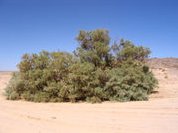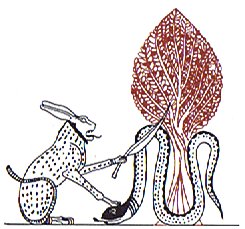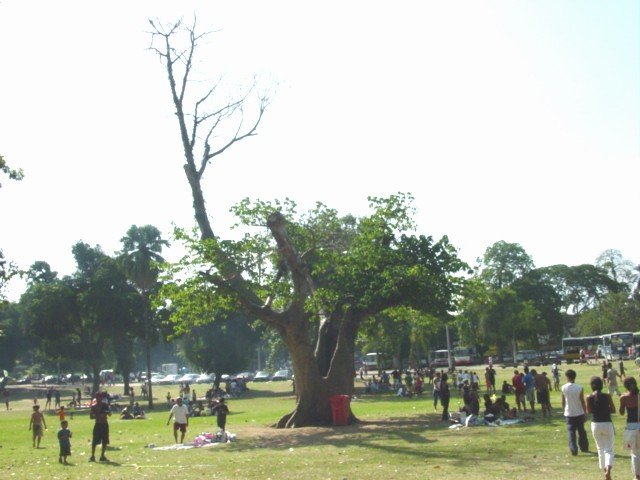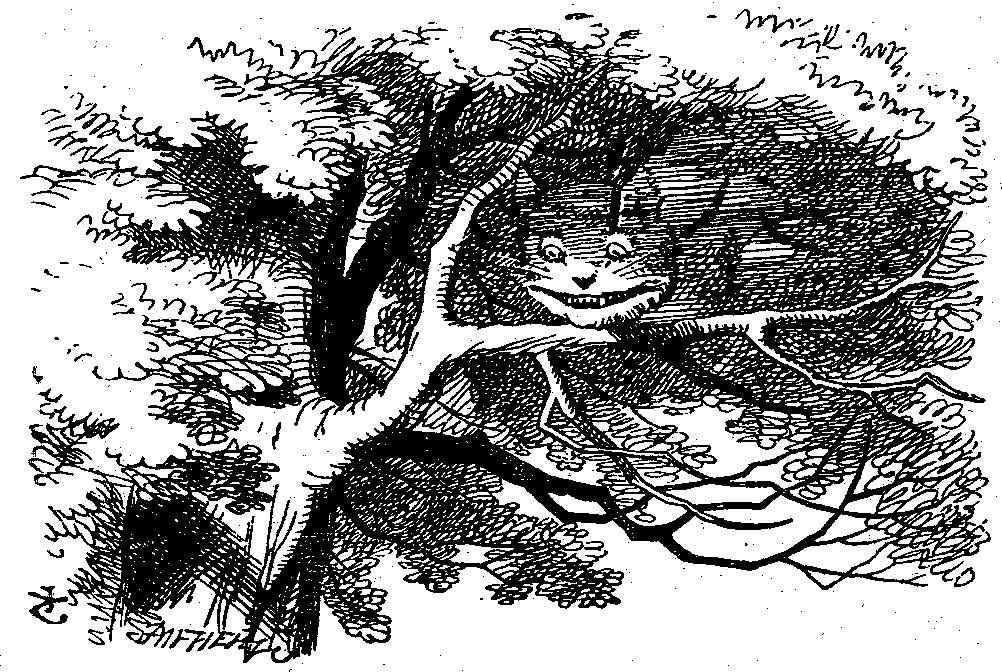The serpent of
spring has 4
supporters.
Together they
rise the sky
roof up to let
in the light:

We now can
understand why
new houses are
inaugurated at
summer solstice:
|
Ko Koró (December) |
|
Because of the increasing heat, work ceases in the fields. Time for fishing, recreation, and festivities. The new houses are occupied (reason for the festivities). Like the previous month, a good time for surfing (ngaru) on the beach of Hangaroa O Tai. |
|
|
...
There
was
a
young
man
living
in
Riu-o-hatu.
He
planned
to
make
a
feast
(koro)
for
his
father.
For
that
purpose
he
raised
chickens
and
had
a
house
built.
All
his
people
worked
on
it.
When
his
koro
house
was
finished,
he
left
his
people
and
went
to
Ahu-te-peu
to
call
on
Tuu-ko-ihu
and
ask
him
for
a
statue.
He
arrived
at
Tuu-ko-ihu's
place
and
asked:
'Give
me a
statue,
o
king,
in
loan
for
the
feast
in
honor
of
my
father.'
The
ariki
said:
'It
is
all
right.'
Tuu-ko-ihu
gave
him
an
image.
The
young
man
took
it
and
returned
to
his
koro.
He
broke
sugar-cane
stalks,
dug
out
yams
and
sweet
potatoes
and
put
bananas
in a
ditch.
He
lit
the
oven
and
put
in
it
fowls,
yams,
and
sweet
potatoes.
Some
people
sang
riu
chants,
others,
ei
chants
and
others
a
te
atua.
They
took
all
the
foods
-
bananas,
sugar
cane,
fowls
- to
the
koro
house.
They
set
up
the
image
at
the
door
of
the
koro
house,
and
the
people
went
to
admire
this
image.
They
spent
three
days
in
the
koro
house.
This
koro
house
was
nice,
and
the
people
ate
plenty
of
sugar
cane
and
bananas.
When
the
koro
was
finished,
the
young
man
stayed
there.
The
third
day,
the
koro
caught
fire.
Men,
women,
and
children
shouted:
'The
koro
is
burning,
the
koro
is
burning.'
This
cry
sounded
at
Hanga-roa,
at
Motu-tautara,
at
Ahu-te-peu.
Tuu-ko-ihu
heard
it
and
said:
'O
my
brother
'The
jumping-little-bird'
(piu-hekerere)
jump!'
A
servant
of
Tuu-ko-ihu
was
sent
to
Riu-o-hatu.
When
the
young
man
saw
him,
he
said:
'Your
image
is
burnt
up.'
The
servant
said:
'No,
it
did
not
burn.'
He
looked
for
it
and
found
it
lying
far
away.
The
servant
called
the
owner
of
the
koro
and
said.
'Here
is
your
image.'
He
returned
it
to
Tuu-ko-ihu
... |
When the serpent
is 'beheaded' at
summer solstice,
his supporters -
which represent
the pillars at
the 4 corners of
the 'house' -
will follow the
spirit of the
serpent in his
canoe.
Presumably also
the 'bacabs'
perished in the
'fire' when the
new house
'burnt'.

... Among the
multitude of
gods worshipped
by these people
[the Maya] were
four whom they
called by the
name Bacab.
These were, they
say, four
brothers placed
by God when he
created the
world at its
four corners to
sustain the
heavens lest
they fall ...
The serpent and
his 4 followers
make a voyage to
the west, that
explains hua
poporo in
Ka5-4:

We are now in a
position to
securely
identify
Aa1-5--8 with
the 'bacabs':
The promising
youths (moa)
will later on
follow the great
Kuukuu
(the 'planter')
on his way west,
incorporated as
hua in
hua poporo.
We presumably
can read the
same story in
the flowing
skirt of
Chimalman:
... His virgin
mother,
Chimalman -
the legend tells
- had been one
of the three
sisters to whom
God, the
All-Father, had
appeared one day
under his form
of
Citlallatonac,
'the
morning'. The
other two had
been struck by
fright, but upon
Chimalman
God breathed and
she conceived.
She died,
however, giving
birth, and is
now in heaven,
where she is
revered under
the honourable
name of 'the
Precious Stone
of Sacrifice',
Chalchihuitzli ...

3
phases in the
development are
depicted:
swimming healthy
youth, twisted
mature man with
his young (left)
half 'dead' (not
fallen on the
front side but
fallen on the
back side), and
lastly a kind of
coffin adorned
with 4 'knobs'
at the top.
The twisted man
has 3+4 ribs and
1 seems to have
been lost (Eve?)
in the twisting
operation. His
living front
half carries the
'full moon' sun
on his back -
like a burden.
One in the party
'got away', i.e.
one of them will
return in some
form next
season:
 |
 |
- |
- |
 |
|
Aa1-13 |
Aa1-14 |
Aa1-15 |
|
... |
... |
... |
 |
 |
 |
 |
 |
|
Ha6-101 |
Ha6-102 |
Ha6-103 |
Ha6-104 |
Ha6-105 |
 |
 |
 |
 |
 |
 |
|
Pa5-67 |
Pa5-68 |
Pa5-69 |
Pa5-70 |
Pa5-71 |
Pa5-72 |
|
This
sequence
of
glyphs
does
not
appear
in Q |
Here - in
winter -
there are 3
'droplets'
and they (Nut,
Isis,
and Hathor?)
may possibly
support a
tamarisk or
a sycomore:
|
... Tamarix can spread both vegetatively, by adventitious roots or submerged stems, and sexually, by seeds. Each flower can produce thousands of tiny (1 mm diameter) seeds that are contained in a small capsule usually adorned with a tuft of hair that aids in wind dispersal. Seeds can also be dispersed by water. Seedlings require extended periods of soil saturation for establishment.

Tamarix species are fire-adapted, and have long tap roots that allow them to intercept deep water tables and exploit natural water resources. They are able to limit competition from other plants by taking up salt from deep ground water, accumulating it in their foliage, and from there depositing it in the surface soil where it builds up concentrations lethal to many other plants ... |
|
 
... The 'tree of life' (in the hieroglyphic sign nehet) was (according to Wilkinson) a 'sycomore' or 'mulberry fig tree', but in the two pictures above we instead see isched, probably Mimusops Schimperi. Via Wikipedia we will first take a look at the Ficus Sycomorus:

Ficus sycomorus, called the sycamore fig or the fig-mulberry (due to the leaves' resemblance to those of the Mulberry), sycamore, or sycomore, is a fig species that has been cultivated since early times ...
F. sycomorus is in the Near Orient a tree of great importance and very extensive use. It has wide-spreading branches and affords a delightful shade. The ancient Egyptians cultivated this species 'almost exclusively', according to Zohary and Hopf. Remains of F. sycomorus begin to appear in predynastic levels, and in quantity from the start of the third millennium BC. Zohary and Hopf note that 'the fruit and the timber, and sometimes even the twigs, are richly represented in the tombs of Early, Middle and Late Kingdoms. In numerous cases the parched sycons bear characteristic gashing marks indicating that this art, which induces ripening, was practice in Egypt in ancient times.' Although this species of fig requires the presence of the symbiotic wasp Ceratosolen arabicus to reproduce sexually, and this insect is extinct in Egypt, Zohay and Hopf have no doubt that Egypt was 'the principal area of sycamore fig development.' Some of the caskets of mummies in Egypt are made from the wood of this tree.'
I notice that a tree can give shadow (a possible meaning of GD28, mauga). I also read that the leaves of this tree are arranged 'spirally around the twig', that the inner bark is yellow, and that some mummy caskets were made from wood of this tree. Furthermore, that the leaves are dark green on one side and 'lighter with prominent yellow veins' on the other side. Wilkinson says that in chapter 109 of the Book of the Dead two 'turquios sycomores' are standing at the eastern gate of the sky, where the sungod Ra enters. The sycomore was a manifestation of the 3 goddesses Nut, Isis, and Hathor, a manifestation by the name 'The Sycomore Lady'.
When I searched in Wikipedia for the tree (isched) infested by the snake I had no success. But I found another internet site of possible use, Ägyptologie Forum, http://www.aegyptologie.com/forum/cgi-bin/YaBB/YaBB.pl?action=lexikon:
'Heiliger jd-Baum im Bereich des Sonnentempels von Heliopolis, vermutlich ein Persea-baum. In einer MR Version des Kap. 17 des TB wird der jd-Baum als der heliopolitanische Baum erwähnt, der sich in der Nacht des Kampfes gegen die Feinde des Re spaltete.' |
The Cat is
the one who
is winning
over the
Snake, at
least half
of the time.
I remember
the Chesire
Cat (in
Carroll),
who had
climbed up
into the tree
but who
slowly
vanished in
front of
Alice, until
only his
smile
remained -
which as if
by chance
had the form
of
canoe:
.jpg)
















.jpg)
